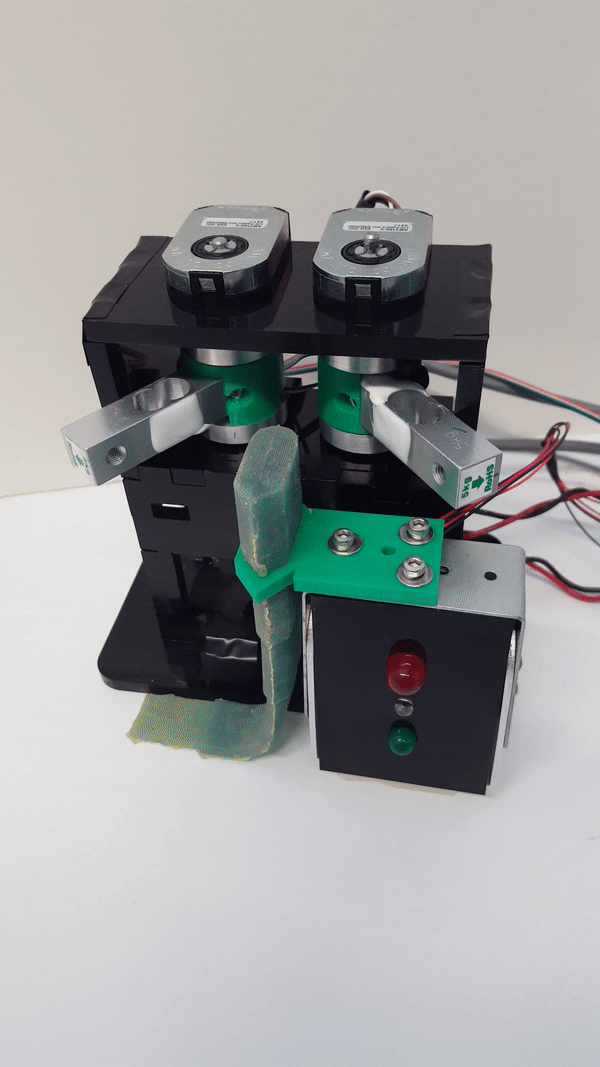Given the lack of force feedback available to clinicians performing laparoscopic and robot-assisted surgeries, it is often difficult to determine how much force to apply to a tissue. This issue is further complicated by the wide variety of tissue types founds in the human body. By using a laparoscopic grasper outfitted with force and displacement sensors, this research device is able to identify the type of tissue being grasped in real time. This information can then be conveyed to the surgeon in order to avoid damaging anatomy.
To apply this research to existing surgical tools, such as a da Vinci robot, a major challenge exists in measuring force at the site of tissue grasping. Another aspect of this research includes estimation of force for da Vinci surgical tools using existing back-end sensors. The methods for accomplishing this include machine learning techniques such as neural networks.
The current researcher for this project is Trevor Stephens. Previous researchers include Rodney Dockter, Nathan Kong, Astrini Sie, and Michael Winek
Relevant Publications:
| [1] | Nathan J Kong, Trevor K Stephens, and Timothy M Kowalewski. Da Vinci Tool Torque Mapping Over 50,000 Grasps and Its Implications on Grip Force Estimation Accuracy. In Medical Robotics (ISMR), 2018 International Symposium on, pages 1--6. IEEE, 2018. [ .pdf ] |
| [2] | John J O'Neill, Trevor K Stephens, and Timothy M Kowalewski. Evaluation of torque measurement surrogates as applied to grip torque and jaw angle estimation of robotic surgical tools. IEEE Robotics and Automation Letters, 3(4):3027--3034, 2018. [ .pdf ] |
| [3] | Trevor K. Stephens, John J. O'Neill, Nathan J. Kong, and Timothy M. Kowalewski. Impact of jaw orientation on grip force estimation for a da vinci endowrist surgical tool. In The Hamlyn Symposium on Medical Robotics, 2018. [ .pdf ] |
| [4] | Trevor K Stephens, John J O'Neill, Nathan J Kong, Mark V Mazzeo, Jack E Norfleet, Robert M Sweet, and Timothy M Kowalewski. Conditions for Reliable Grip Force and Jaw Angle Estimation of Da Vinci Surgical Tools. International Journal of Computer Assisted Radiology and Surgery, pages 1--11, 2018. [ .pdf ] |
| [5] | Nathan J Kong, Trevor K Stephens, John J O'Neill, and Timothy M Kowalewski. Design of a portable dynamic calibration instrument for davinci si tools. In 2017 Design of Medical Devices Conference, pages V001T11A023--V001T11A023. American Society of Mechanical Engineers, ASME Digital Collection, 2017. [ .pdf ] |
| [6] | Mark J Brown, Trevor K Stephens, John J O'Neill, and Timothy M Kowalewski. Effects of Grasp Frequency on the Dynamics of a Robotic Surgical Grasper. ASME Journal of Medical Devices, 10(3):030957, 2016. [ .pdf ] |
| [7] | Rodney L. Dockter, John J. O'Neill, Trevor K. Stephens, and Timothy M. Kowalewski. Feasibility of tissue classification via da vinci endowrist surgical tool. In The Hamlyn Symposium on Medical Robotics, pages 64--65, 2016. [ .pdf ] |
| [8] | Trevor K Stephens, Zachary C Meier, Robert M Sweet, and Timothy M Kowalewski. Tissue identification through back end sensing on da vinci endowrist surgical tool. ASME Journal of Medical Devices, 9(3):030939, 2015. [ .pdf ] |
| [9] | Astrini Sie. Online identification of abdominal tissues during grasping using an instrumented laparoscopic grasper. Master's thesis, The University of Minnesota Twin Cities, 2013. [ .pdf ] |
